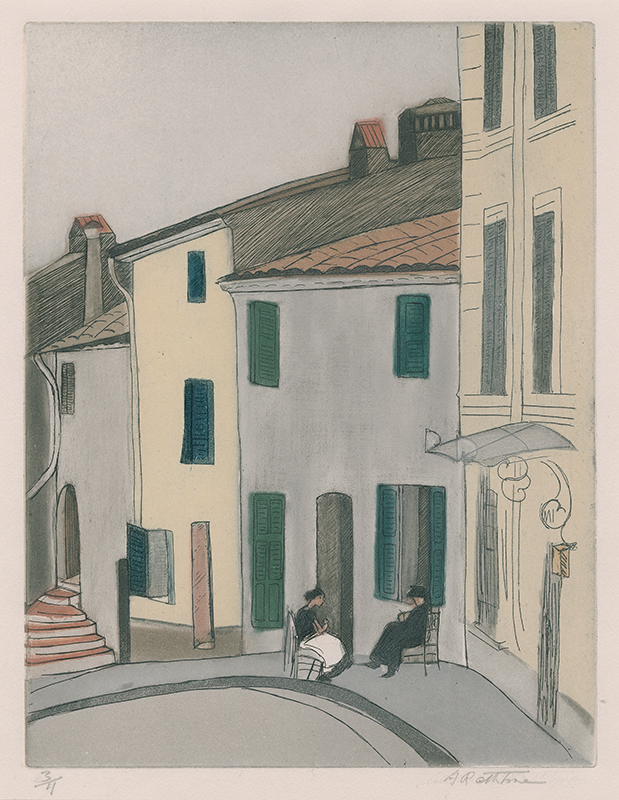Cagnes is an etching and color aquatint created about 1936 by American artist, Augusta Rathbone. It is pencil signed and editioned 3/4. It is further inscribed on verso Cagnes / French Riviera. Cagnes was printed in Paris by Monsieur Porcabeuf on an unidentified cream wove paper and the platemark measures 10-5/8 x 8-1/8 inches.
Cagnes is a town situated on the French Riviera and lies just beyond Nice and the town Saint-Laurent-du-Var. It was originally a hilltop town surrounded by protective walls but the town has since spilled down the hillside to the sea. The lower portion is referred to as Cagnes-sur-Mer while the original old town is Haut-de-Cagnes. in 1983, Virginia Thompson wrote of Cagnes, “The people of Cagnes have long enjoyed a reputation for gaiety rather than piety. Their incessant street dancing, flute and tambour playing, and indecent dress brought upon them the censure of the Bishops of Grasse…And it has retained its bohemian, insouciant character. For many decades Cagnes has swarmed with painters of every nationality; the most famous of these adopted sons was Renoir, whose garden is still cherished.”
Rathbone was a colorist, minimalist, and modernist fusing flat colors with skillfully delineated lines to form a striking image. Rathbone used two plates, one for etching and one for aquatint, and in her early career relied on Monsieur Alfred Porcabeuf to print her plates. She traveled throughout the French Riviera in the mid 1930s and recorded the scenes in watercolor and drawing. A chance encounter with Juliet and Virginia Thompson resulted in the 1938 book French Riviera Villages in which Rathbone’s original aquatints were reproduced in pochoir.
Augusta Payne Briggs Rathbone, painter and printmaker, was born in Berkeley, California on 30 November 1897. In 1900, her parents, Henry and Julia Briggs Rathbone, were living in the San Francisco home of her grandparents, Obil and Mary Briggs, and that same year her mother passed away. After the 1906 earthquake and conflagration, Rathbone was sent to live in Berkeley with her aunt, Edith Moses. Rathbone eventually returned to San Francisco where she attended Miss Hamlin’s School for Girls and Young Ladies. She received her BA degree from the University of California Berkeley in 1920 and the following year she sailed to Paris where she continued her studies at the Académie de la Grande Chaumière. She also studied with Lucien Simon and for several years with the Spanish artist Claudio Castelucho y Diana.
Rathbone returned to France for extended periods over the next eighteen years and her studio was located at the University Women’s Club now known as Reid Hall. Painting and sketching were her main interests until her introduction to printmaking in 1927 by the artist Nora Hamilton of Chicago. Rathbone began to concentrate on printmaking and took her plates to Monsieur Alfred Porcabeuf in Paris for printing. Her earliest intaglios featured the Sierra Nevada and urban scenes of New York and San Francisco. In the late 1930s, Rathbone created etching and aquatints of the villages in Brittany and the French Riviera. After World War II, she returned to Paris but in the face of prohibitive printing costs she purchased a small press and taught herself how to print her plates.
Rathbone exhibited at the Salon de Nationale, Paris, in the spring of 1930, 1931, and 1933 and in the autumn salons of 1930 and 1937. Her work was included in the exhibition American Color Prints at the Brooklyn Museum in 1933, and a solo exhibition of her work was mounted at the San Francisco Museum of Art in 1940. Her work and that of Elizabeth Ginno were featured at the California State Library in Sacramento in 1952 and again, in 1954, at the de Young Museum in San Francisco. Rathbone's artistic affiliations included memberships in the California Society of Etchers, San Francisco Women Artists, San Francisco Art Association, American Artists Professional League, and the National Arts Club.
In 1938, Rathbone joined forces with Juliet and Virginia Thompson to create the illustrated book, French Riviera Villages, published that year by Mitchell Kennerly. Twelve of Rathbone’s original color aquatints were reproduced, Juliet Thompson provided photography of the villages, and Virginia Thompson wrote a history on each village. The women joined forces to distribute their book after Kennerly failed to do so.
Augusta Rathbone's work is represented in the collections of the Baltimore Museum of Art, Maryland; the Brooklyn Museum, New York; the Bowdoin College Museum of Art, Brunswick, Maine; the Indianapolis Museum of Art, Indiana; the Zimmerli Art Museum, Rutgers University, New Brunswick, New Jersey; the Whitney Museum of American Art, New York; the Fine Arts Museums of San Francisco, California; the National Gallery of Art, Washington, D.C.; the Davis Museum at Wellesley College, Massachusetts; and the Worcester Art Museum, Massachusetts.
Augusta Payne Briggs Rathbone died on 19 March 1990 in Palo Alto., California.



